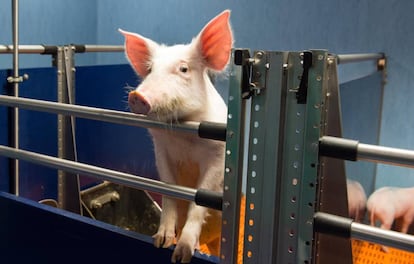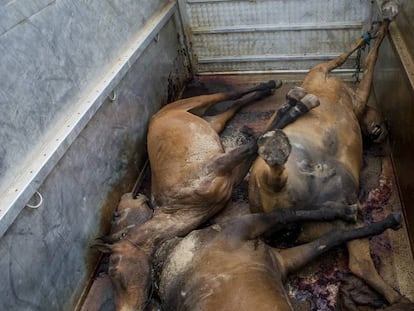Labs that experiment with animals start to lift veil of secrecy
But two years after Spanish centers signed a transparency agreement, 20% have yet to offer visits

In late 2014, the Biomedical Primate Research Center in the Dutch city of Rijswijk unexpectedly opened its doors to a team of journalists from Vice News. The visit produced a 20-minute documentary that began with footage of scientists arriving at the biggest testing site of its kind in Europe on bicycles amid cries of “You have blood on your hands!” from animal rights activists.
The film showed researchers dissecting monkeys with scalpels while explaining why these kinds of studies are still indispensable in the fight against diseases such as AIDS, malaria, tuberculosis, Parkinson’s Disease and hepatitis, which between them kill millions of people across the world every year. With 1,500 monkeys on its premises, the center has a link to the documentary on its own website.
Transparency will help all of us to learn about the tremendous benefits we get from animal experimentation
Margarita del Val, biochemist
Spain is still a long way off from this level of transparency. It was only two years ago that the main Spanish research organizations agreed to lift the veil of secrecy on animal testing. But according to a report from the European Animal Research Association (EARA), 20% of those who signed the agreement drafted by the Confederation of Spanish Scientific Societies admit that they have still not been open to visits. For the past two years, EL PAÍS has been requesting permission to film the research carried out on monkeys in Spain, to no avail.
Spanish researchers used around 910,000 animals for the first time in 2016 and reused around 8,500 of them, mainly for cancer research and diseases of the heart and the nervous system, according to a report from the Ministry of Agriculture. To put these figures in perspective, there were 30 million pigs destined for food in Spain in December 2017.
Pressed by EU legislation to publish the EARA report, the Spanish Ministry of Agriculture has done so in an obscure corner of its website, without an official presentation or even a press release to the media, reminiscent of the lack of transparency that prevailed in the past.
The fear is justified because we have examples of research centers which have been attacked
Lluís Montolíu, National Biotechnology Center
The immense majority of animals used in scientific research are mice (540,000), fish (169,000), poultry (90,000), rats (55,000) and rabbits (28,000). Experimentation on dogs (1,083), cats (358) and macaques (228) is more the exception than the rule.
“It must be made clear that an animal testing laboratory is neither a zoo nor a circus,” says the vet Javier Guillén, European and Latin American director for the non-profit International Association for the Evaluation and Certification of the Care of Laboratory Animals, which advocates a humanitarian treatment of animals. “There are factors that make limiting visits necessary, such as bio-security. And there are institutions that have not taken the step [to open their doors] because of bad experiences in the past or because they want to avoid problems with animal rights groups.” One such institution is the pharmaceutical company GSK, which did not even sign the agreement.
“The fear is justified because we have examples of research centers that have been attacked, cages opened and experiments lost,” says Lluís Montoliu, a scientist at the National Biotechnology Center that uses mice to study rare incurable diseases in humans, such as albinism.
The EARA report comments on the “evident and positive” effect of the transparency agreement signed by 123 Spanish organizations, while stating that there is still room for improvement. Half of these organizations have participated in an EARA survey showing that 79% of them report on the scientific progress they make through animal experimentation, while 63% include images on their websites of the mice and other animals used in their research. Another 30% said that they have received a visit from the media following the agreement.
“Out of excessive precaution or ancestral fear, the policy seems to be that if you don’t talk about it, it won’t cause problems,” says Montoliu, who is pushing for greater transparency within the sector in Spain. “This is a big mistake. We researchers will be the first to stop using animals when it is no longer necessary, but right now that’s not the case; they still are.”
Meanwhile, Margarita del Val, who researches viral infections at the Severo Ochoa Molecular Biology Center, is also optimistic. “Transparency will help all of us learn about the tremendous benefits we get from animal experimentation.”
English version by Heather Galloway.
Tu suscripción se está usando en otro dispositivo
¿Quieres añadir otro usuario a tu suscripción?
Si continúas leyendo en este dispositivo, no se podrá leer en el otro.
FlechaTu suscripción se está usando en otro dispositivo y solo puedes acceder a EL PAÍS desde un dispositivo a la vez.
Si quieres compartir tu cuenta, cambia tu suscripción a la modalidad Premium, así podrás añadir otro usuario. Cada uno accederá con su propia cuenta de email, lo que os permitirá personalizar vuestra experiencia en EL PAÍS.
¿Tienes una suscripción de empresa? Accede aquí para contratar más cuentas.
En el caso de no saber quién está usando tu cuenta, te recomendamos cambiar tu contraseña aquí.
Si decides continuar compartiendo tu cuenta, este mensaje se mostrará en tu dispositivo y en el de la otra persona que está usando tu cuenta de forma indefinida, afectando a tu experiencia de lectura. Puedes consultar aquí los términos y condiciones de la suscripción digital.
More information
Archived In
Últimas noticias
Maduro pleads not guilty before the federal court in New York: ‘I am still the president of Venezuela’
A new test can detect Alzheimer’s from a finger prick
UN team enters Sudanese city of El Fasher after paramilitary massacre: ‘It’s like a ghost town’
A recipe for resistance: Indigenous peoples politicize their struggles from the kitchen
Most viewed
- Gilles Lipovetsky: ‘If you want to live better and fall in love, take Prozac, don’t look to philosophy’
- Alain Aspect, Nobel laureate in physics: ‘Einstein was so smart that he would have had to recognize quantum entanglement’
- Maduro’s downfall puts China’s relationship with Venezuela to the test
- Why oil has been at the center of Venezuela-US conflicts for decades
- Alvin Hellerstein, a 92-year-old judge appointed by Bill Clinton, to preside over Maduro’s trial in New York











































